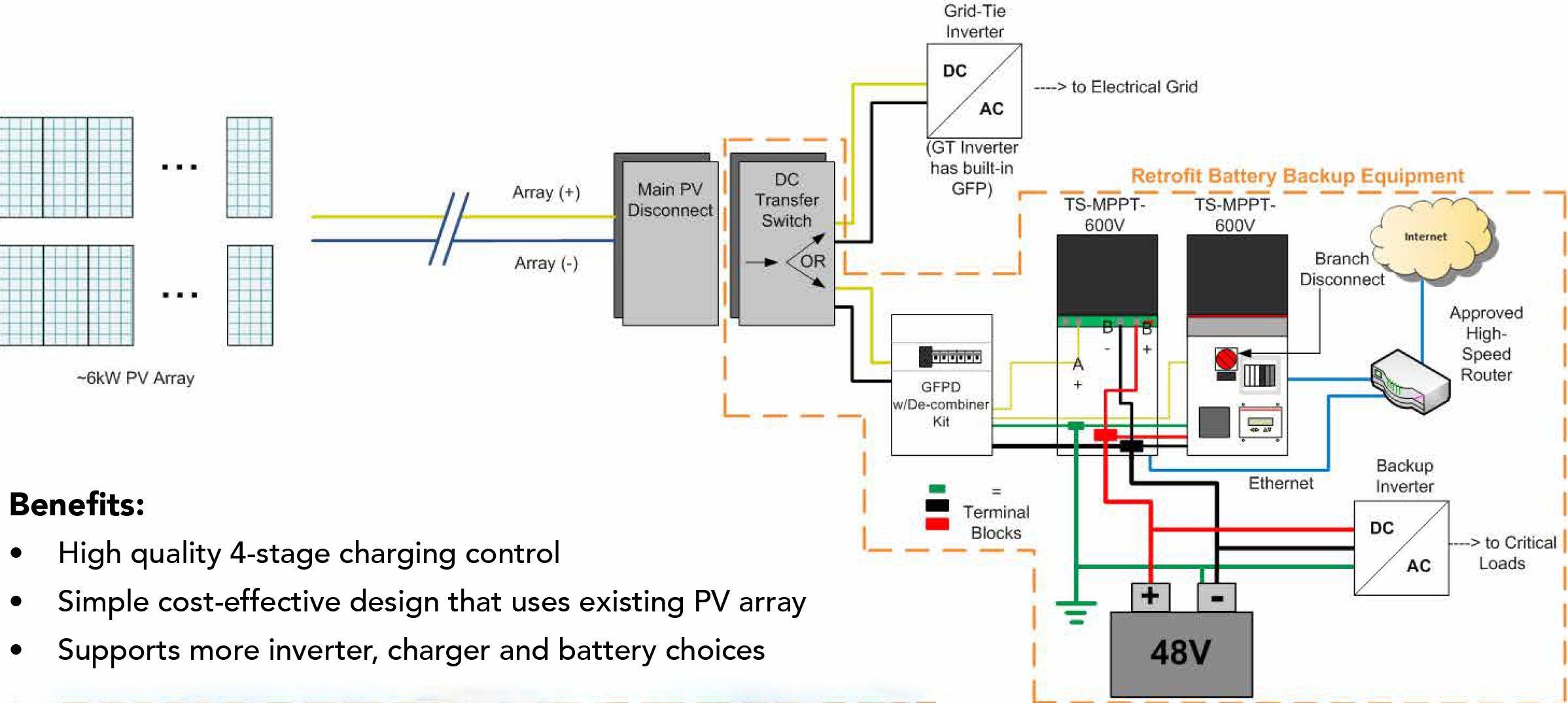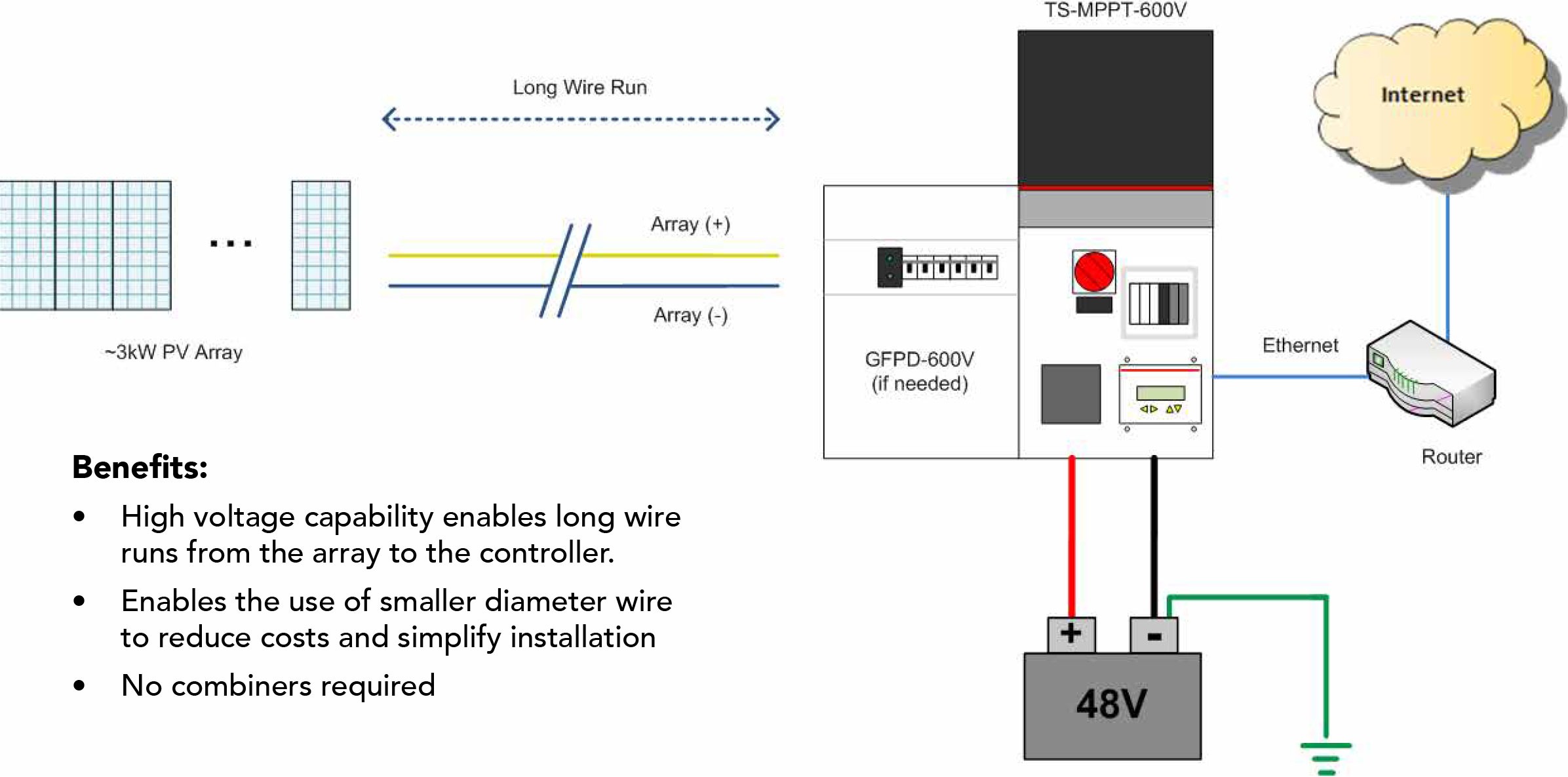Adding Battery Back-up to Existing Grid-Tie Arrays: A Different Approach
 The last five years have seen a growing demand to retrofit existing grid-tie PV systems with battery back-up capability. A traditional grid-tie system, without battery, shuts down during utility outages. Even if it is sunny out, the system does not supply any power to the household. Adding battery capacity allows the household to keep power to its critical loads; with the array collecting power to keep the battery bank charged.
The last five years have seen a growing demand to retrofit existing grid-tie PV systems with battery back-up capability. A traditional grid-tie system, without battery, shuts down during utility outages. Even if it is sunny out, the system does not supply any power to the household. Adding battery capacity allows the household to keep power to its critical loads; with the array collecting power to keep the battery bank charged.
The Original Solution
The original solution was coined AC Coupling, and has seen great success over the last several years. A battery based inverter/charger is inserted as a conduit between the grid-tie inverter and the utility connection panel. The inverter/charger (along with its battery bank) serves to mimic the presence of utility power, allowing the grid-tie equipment, and thus the array, to remain operational throughout a utility outage. The solution is functional and avoided the extreme cost of a complete system overhaul, stripping the system down to its pieces and starting over from scratch.
Like all solutions though, it has its down sides. The insertion of the inverter/charger adds an extra stage, and loss of efficiency, resulting in a decrease in the amount of power being sold to the grid. The battery charging method is crude, bulk “on or off/all or nothing” charging method, which is repeated throughout the day. While okay in limited applications of grid black outs, it is not considered an ideal method of battery charging and is absolutely not appropriate as a long term “off-grid” treatment of batteries. AC Coupling also requires the inverter/charger to be sized for the capacity of the array; or scaled to support only a portion of the grid-tie system. This can add equipment cost and complexity beyond what would otherwise be needed to support the critical/backed-up loads.
Another Solution Exists
 Dubbed High Voltage DC Coupled Charging (HVDCC); Morningstar Corporation has introduced their approach to adding battery banks to existing grid-tie systems. Leveraging their existing technology, Morningstar has retooled their Tristar MPPT 600V charge controller for the application. Rated for array voltages of 600 volts, it is ideally suited to accommodate the high voltages of grid-tie arrays.
Dubbed High Voltage DC Coupled Charging (HVDCC); Morningstar Corporation has introduced their approach to adding battery banks to existing grid-tie systems. Leveraging their existing technology, Morningstar has retooled their Tristar MPPT 600V charge controller for the application. Rated for array voltages of 600 volts, it is ideally suited to accommodate the high voltages of grid-tie arrays.
The addition of double-pole, double-throw manual transfer switch allows the customer to direct the power of their solar array to the grid-tie inverter when the grid is up and operational or to a battery bank during a utility outage. The system is similar to a rechargeable UPS, and is semi-automatic where the loads are backed up automatically but you “plug in your PV charger” Now, with a powerful charge controller regulating PV power, the batteries are treated to the proper four-stage charging that they want and deserve. This makes the solution viable for not only short utility outages, but longer term off-grid operation as well. After utility power is restored, the customer can re-direct the array power back to the grid-tie inverter at their discretion. It is a good idea to keep the array switched to battery for a time in order to bring the back-up batteries to full charge before going back to sell mode to the grid.
The Tristar MPPT 600V controller is protected against over-current on the input. The controller itself can utilize up to 3,200 watts of power for charging the batteries, but it can also safely be inserted on arrays of much higher power with no adverse effects. Being a robust solution, Morningstar has also incorporated a required Ground Fault Protection circuit for additional safety. Morningstar sells this “pre-wired” for a fast install, and to insure that the quality is maintained. This is not an area to purchase a cheaper aftermarket model.
 During day to day operation, when utility power is operating, a simpler inverter/charger, or even an inexpensive trickle charger, can use utility power to keep the battery bank at the ready. The inverter chosen to run off the battery bank during black-outs need only be sized to support the critical loads; allowing for a wider range of products and costs to be considered. Its not only the size or type of inverter which this approach now frees from the constraints of AC Coupling, it’s the size of the battery bank too. With AC Coupling, you have to typically size the off-grid inverter to be at least as big as and as much as 10% bigger than the grid-tie inverter or micro-inverter strings that you currently have. This mandates many times a 48V battery bank for back up. By using DC Coupling, you can size the batteries around the back-up duration and loads that are critical during the outage. This can reduce system costs significantly.
During day to day operation, when utility power is operating, a simpler inverter/charger, or even an inexpensive trickle charger, can use utility power to keep the battery bank at the ready. The inverter chosen to run off the battery bank during black-outs need only be sized to support the critical loads; allowing for a wider range of products and costs to be considered. Its not only the size or type of inverter which this approach now frees from the constraints of AC Coupling, it’s the size of the battery bank too. With AC Coupling, you have to typically size the off-grid inverter to be at least as big as and as much as 10% bigger than the grid-tie inverter or micro-inverter strings that you currently have. This mandates many times a 48V battery bank for back up. By using DC Coupling, you can size the batteries around the back-up duration and loads that are critical during the outage. This can reduce system costs significantly.
 Overall, High Voltage DC Coupled Charging seeks to offer a robust solution for grid-tie retrofit; addressing the short-comings of AC Coupling, while also offering lower cost options, and an increase in functionality, all while reducing the complexity of the implementation. Morningstar’s efforts at early adoption and a strong push to reach out to its vendors have shown Backwoods that they have applied their well-known reputation in their approach to this proven technology. This is an area which we at Backwoods Solar and Morningstar know well, battery storage. This is where solar started, prior to anyone being grid connected and having systems that allowed for net-metering. This is just a new application of a tried and true methodology, pairing batteries with solar charging, now with the ability to safely and simply power your home in a time of outage.
Overall, High Voltage DC Coupled Charging seeks to offer a robust solution for grid-tie retrofit; addressing the short-comings of AC Coupling, while also offering lower cost options, and an increase in functionality, all while reducing the complexity of the implementation. Morningstar’s efforts at early adoption and a strong push to reach out to its vendors have shown Backwoods that they have applied their well-known reputation in their approach to this proven technology. This is an area which we at Backwoods Solar and Morningstar know well, battery storage. This is where solar started, prior to anyone being grid connected and having systems that allowed for net-metering. This is just a new application of a tried and true methodology, pairing batteries with solar charging, now with the ability to safely and simply power your home in a time of outage.
If you’re interested in building or improving your off the grid homes, call us 208-263-4290 or contact us online for more information. Request a Catalog to browse our products at your convenience.

